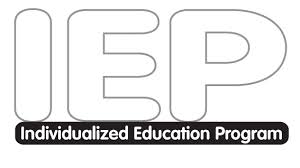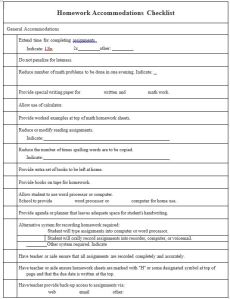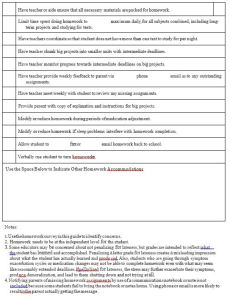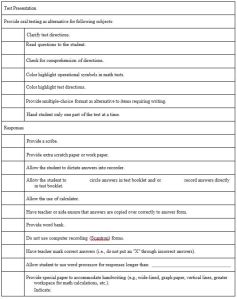Use this checklist to determine which school accommodations would be best for your child. You can download and print the Word document here:Homework Accommodations Checklist
ils@npc
www.ilsatnpc.com
Category Archives: IEP/504 Plan
Testing Accommodations Checklist
Use this checklist to determine which school accommodations would be best for your child. You can download and print the Word document here: Testing Accommodations Checklist
Executive Dysfunction Accommodations Checklist
Use this checklist to determine which school accommodations would be best for your child. You can download and print the Word document here: Executive Dysfunction Accommodation Checklist
Next Steps
1. You or other observers (family, teachers, etc.) suspect your child has a cognitive challenge.
2. You or other observers feel this cognitive challenge affects your child’s performance in school.
3. Document warning signs. Start compiling documents that substantiate poor grades, behavior, reports, and hurt feelings that follow your child home from school.
4. Research educational advocates. This can be an old teacher, a spouse, a friend or someone more formal that is hired to help you, depending how difficult the process is and whether or not you agree with the school’s recommendation.
5. Schedule a teacher meeting. Gather all the firsthand information you can while also building important and positive relationships with teachers, new and old.
6. Request an IEP meeting/evaluation. Options for the evaluation include a school assessment or seeking an independent evaluation with a neuropsychologist or other specialist to obtain their professional opinion and establish a formal diagnosis.
7. Meet with the IEP team to review the assessment results and other information.
o Gather all your supporting documents and consider bringing your educational advocate along.
o Research and develop a list of homework and classroom accommodations you feel will work for your child. Make copies of this list for each person attending the meeting and be prepared to draft these into the IEP with the team.
o Develop detailed goals with the school team.
8. If you disagree with the team’s conclusions and recommendations, options include requesting 504 accommodations, submitting a formal written request for an independent education evaluation (IEE; if not already conducted), and requesting mediation or a due process hearing (consider hiring a professional educational advocate).
9. Summarize the results. After agreeing upon and signing the IEP plan, summarize the results in a thank you note to each school official. This not only is a nice gesture that helps build a positive relationship with the school, but also acts as a reminder to school staff.
10. Track progress towards goals. Develop a plan with teachers regarding communication throughout the school year. Track your child’s progress and request adjustments if necessary.
Individualized Education Program (IEP) Facts

• The Individuals with Disabilities Education Improvement Act (IDEIA 2004) requires public school to provide special education services to all children with disabilities who are eligible to receive them in order to receive a free appropriate public education (FAPE).
• The IEP is a written document that annually specifies the services/accommodations that are calculated to allow your child to receive educational benefit. It must allow your child the opportunity to interact with like-age peers to the maximum extent appropriate.
• Local public school systems are responsible for providing special education to eligible children from ages 3 to 21 – even if it involves more than 12 years of instruction.
• In order for your child to have an IEP, he/she must be eligible. By federal law, a multidisciplinary team must determine that your child: (1) has a disability (2) requires special education and related services to benefit from the general education program. Thirteen disabilities qualify for services under the IDEA, including:
o Emotional Disability
o Intellectual Disability (formerly Mental Retardation)
o Specific Learning Disability
o Speech or Language Impairment
o Other Health Impairment (including AD/HD)
• If your child is struggling in school and you suspect a disability, request an evaluation from the school district’s special education coordinator or seek an independent evaluation. An IEP team that includes the parents must meet “in a timely manner” to review the referral and decide whether an evaluation should be conducted.
• The evaluation process includes the administration of assessments and testing, observations, and collection information from any available outside professionals as well as from parents.
• Timeline for school evaluations:
o 60 calendar days from date of written consent to complete all necessary evaluation.
o 30 calendar days from completion of evaluation for IEP team to meet
o Implement IEP as soon as possible after it is created
• Each IEP is created through a TEAM effort and reviewed at least once a year. A parent (or legal guardian) is included on the team and must sign a document permitting the IEP to be implemented.
• Reevaluations are required at least once every three years to determine continued eligibility and make appropriate adjustments. A reevaluation may also be requested if the IEP does not appear to be working (the request must be reviewed and approved by the team).
• IEP forms differ from state to state and sometimes from school to school. There are no federal regulations on how the IEP should look, though federal law requires that the IEP include present levels of educational performance, goals, and special education and related services.
• Additional information: “Special Education in Alabama: A Right Not a Favor” available at the Alabama Disabilities Advocacy Program’s website http://www.adap.net (under the publications tab).
504 Accomodations
Examples of Possible
Accommodations or Interventions
for a Section 504 Plan
MARY DURHEIM
This form lists examples of accommodations or inter¬ventions that a school district might offer a student with a disability to help him/her achieve success in school. Every student has different needs and the plan should be customized to those needs. A profile of the needs should first be done, then prioritized. Even though some students may need more accom-modations/interventions than others, it is important for parents and educators to be realistic and not try to “fix” everything at once. Choose the most critical areas of concern and then target SEVERAL accom¬modations or interventions that can realistically be accomplished by the team of the parent, the teacher(s) and the student.
Areas of Concern:
Activating and getting started
Irritability, depressed mood, sensitive to criticism
Memory, recall
Motor activity
Compliance
Academic skills
Sustaining attention and concentration
Sustaining effort
Impulsiveness
Organizing and planning
Socialization
Accommodation by Teacher:
Physical Arrangement of Room-
Seating student near teacher
Standing near student when given directions or presenting lessons
Increasing the distance between the desks
Seating student near positive role model
Avoiding distracting stimuli (high traffic areas, windows, heating system
Additional accommodations:
Lesson Presentation-
Pairing students to check work
Writing key points on the board
Providing peer tutoring
Providing visual aids
Providing peer note taker
Making sure directions are understood
Break longer presentations into shorter segments
Providing written outline
Allowing student to tape record lesson
Having student review key points orally
Teaching through multi-sensory modes
Using computer-assisted instruction
Include a variety of activities in each lesson
Additional accommodations:
Assignments/Worksheets-
Giving extra time to complete tasks
Simplifying complex directions
Handing worksheets out one at a time
Reducing the reading level of the assignment
Providing study skills training/learning strategies
Allowing student to tape record assignments/homework
Shortening assignments; breaking work into smaller segments
Allowing typewritten or computer printed assign¬ments
Using self-monitoring devices
Reducing homework assignments
Not grading handwriting
Requiring fewer correct responses to achieve grade
Giving frequent shorter quizzes and avoiding long tests
Additional accommodations:
Test Taking-
Allowing open book exams
Giving exams orally
Giving take home tests
Allowing student to give test answers on tape recorder
Giving frequent short quizzes, not long exams
Allowing extra time for exams
Reading test items to student
Giving more objective items (fewer essay responses)
Additional accommodations:
Organization-
Providing peer assistance with organizational skills
Providing student with extra set of books for home
Providing student with an assignment notebook
Providing rules and help with getting organized
Checking homework daily
Setting short-term goals for work completion
Assigning volunteer homework buddy
Sending daily/weekly progress reports home
Requesting parental help with organization
Supervising writing of homework assignments
Giving assignments one at a time
Additional accommodations:
Behaviors-
Providing frequent, immediate, positive feedback
Using self-monitoring strategies
Contracting with student
Increasing the immediacy of rewards
Using “prudent” reprimands, avoiding lecturing
Using nonverbal cues to stay on task
Implementing a classroom behavior management system
Anticipate problems and use preventative strategies
Praising specific behaviors
Allowing legitimate opportunity to move
Giving extra rewards and privileges
Implementing time-out procedures
Allowing short breaks between assignments
Making student correct answers, not his mistakes
Ignoring minor inappropriate behaviors
Supervising during transition times
Additional accommodations:
Mood-
Provide reassurance and encouragement
Speak softly in non-threatening manner if student is nervous
Focus on student’s talents and accomplishments
Make time to talk alone with student
Look for signs of stress build up and provide encouragement or reduced work load
Allow student an opportunity to “save face”
Give student choices
Train to control anger: encourage student to walk away; use calming strategies
Compliment positive behavior and work
Look for opportunity for student to display lead¬ership role in class
Send positive notes home
Reinforce frequently when student is frustrated
Use mild, consistent consequences
Additional accommodations:
Academic Skill-
If READING is weak: provide extra time; use “previewing” strategies; select text with less on a page; shorten amount of reading required; avoid oral reading
If ORAL EXPRESSION is weak: accept all oral responses; substitute display for oral report; encourage expression of new ideas; pick topics easy for student to talk about
If WRITTEN LANGUAGE is weak: accept non-written forms of reports; accept use of typewriter, tape recorder; do not assign large quantities of written work; test with multiple choice or fill-in blanks
If MATH is weak: allow use of calculator; use graph paper to space numbers; provide extra math time; provide immediate correctness feed¬back and instructions by modeling the correct computational procedure: teach the steps needed to solve a particular math problem; give clues to the process needed to solve problem; encourage use of “self-talk” to problem-solve.
Medication
Physician:
Medication:
Dose:
Schedule:
Administered in school by:
Parent education re: AD/HD
Parent education re: behavior management
Provide positive reinforcement for points earned in behavior program at school
Write questions, concerns in assignment note¬book to communicate with teacher(s)
Community agency involvement
Break homework into smaller parts and provide frequent breaks
Communicate concerns to teacher(s)/ counselor
Inform teacher(s)/counselor of medication changes
Get feedback from teacher(s)/counselor to give physician for check-ups
Additional accommodations:
Special Considerations-
Monitor student closely on field trips
Inservice teacher(s) on child’s handicap
Provide social skills group experiences
Develop intervention strategies for transitional periods (i.e., cafeteria, recess, assemblies)
Alert school bus driver
Provide group/individual counseling re:
Additional accommodations:
Parent Involvement-
Initial assignment notebook daily/weekly
Provide daily rewards for bringing completed assignment notebook/progress note home
Call teacher(s) every for feedback
Call homework hotline for assignments
Supply school with medication and necessary medical forms
Parent support group (e.g., CHADD)
Participants Name:
504 Plan Facts
• Section 504 is a civil rights statute that prohibits discrimination on the basis of disability I any program or activity that receives federal financial assistance – including schools – and ensures that people with disabilities have equal access to participate in services and activities as persons without disabilities.
• Section 504 requires schools to provide a free appropriate public education (FAPE) to eligible students, including regular or special education and related aids and services that are designed to meet the individual needs of your child as adequately as the needs of children without disabilities are met.
• If your child has been found ineligible for services under the IDEA, always ask the evaluation team to consider whether he/she may be eligible for services under Section 504. If your child has already been properly evaluated for eligibility under the IDEA, the evaluation requirements under section 504 have already been met and no further evaluation should be necessary. Eligibility requires that a child have a physical or mental impairment that substantially limits one or more major life activities (e.g., speaking, reading, thinking, concentrating, communicating, interacting with others, learning). This determination is made on a case-by-case basis by a Section 504 team.
• A 504 plan consists of accommodations or interventions that a school provides to a student with a disability to help him/her achieve success in school (see attached examples).
• A 504 plan can apply to any child between the ages of 3 and 22 who has a mental or physical disability that substantially limits their everyday progress in school.
• If your child has good grades, they may still get a 504 plan. There was an amendment to the 504 plan that covers disabilities regardless of academic performance. Ask your school for a copy of its Section 504 evaluation, reevaluation, placement, and due process procedures.
• There is no specific federal requirement that 504 meetings/referrals include parents; however, most school districts have policies in place that require parents to be part of the process.
• Typically, a doctor’s diagnosis of a disability is just one piece of information needed in determining eligibility. The team must also determine whether the disability results in an impairment and then whether that impairment substantially limits a major life function.
• Every school district must establish procedural safeguards under Section 504 that provide for:
o Parental consent to be provided before any evaluation can take place.
o Notice to parents explaining any evaluation and placement decisions affecting your child.
o An opportunity to examine relevant educational records for your child.\
o An impartial hearing process that includes the opportunity for you to participate and be represented by counsel and that allows the review of decision made regarding eligibility, services or placement to be reviewed.
• When a 504 plan is applied to a child, the school is obligated by federal law to follow the plan. Disputes can be handled through an impartial hearing from the school or by filing a complaint with the Office for Civil Rights (for matters involving procedural issues).











